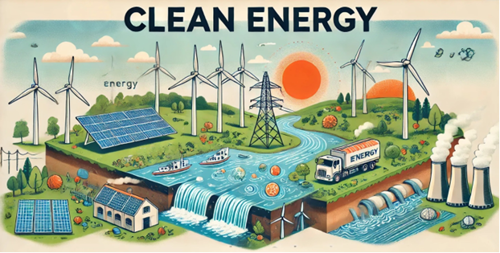The United Kingdom's unwavering commitment to sustainability is vividly illustrated by the burgeoning clean energy sector, currently valued at £22 billion and projected to escalate to £46 billion by 2035. This promising growth is propelled by an ambitious workforce of over 140,000, underscoring the sector's role as a catalyst for economic vitality and job creation within renewable energy technologies.
Despite the challenges posed by policy fluctuations, which have injected a degree of uncertainty, the UK remains a global leader in clean energy innovation and investment. Ranked sixth worldwide for clean energy investment, the nation's robust infrastructure and progressive policy framework continue to attract investors. However, the shifting regulatory environment demands that policymakers reinforce this progress with consistent and clear regulations to sustain investor confidence and stimulate further economic growth.
In the North East of Scotland, renewable energy is emerging as the cornerstone of economic development, eclipsing traditional sectors like Oil and Gas. The burgeoning offshore wind projects off the East Coast are poised to deliver significant economic returns, with investments potentially reaching into the billions and creating tens of thousands of jobs. The Energy Transition Zone in Aberdeen is a prime example of the region's proactive stance on green technologies, leveraging its oil and gas expertise to pivot towards sustainable energy solutions.
As a testament to the efficacy of these initiatives, nearly 80% of Britain's electricity on certain days is derived from low-carbon sources, with wind power contributing significantly. This shift not only reduces reliance on fossil fuels but also plays a critical role in curbing greenhouse gas emissions. Furthermore, the expansion of the 'net zero economy' to £74 billion in 2023 vividly demonstrates the significant impact of green industries on the UK's economic landscape, highlighting the necessity for ongoing investment and supportive policies.
The transformation toward clean energy in the UK is not only a strategic imperative but also an environmental and economic necessity.
Understanding Clean Energy
Clean energy, also known as renewable or green energy, is derived from sources that are sustainable and do not deplete natural resources. Unlike traditional fossil fuels, which produce significant greenhouse gas emissions and pollutants, clean energy sources generate minimal to zero emissions. These sources are crucial in the global effort to combat climate change and protect the environment. Key types of clean energy include solar, wind, hydropower, geothermal, biomass, tidal & wave energy, and hydrogen. These sources harness natural processes to produce energy in a way that significantly reduces environmental impact.

Key Sectors of Clean Energy
The clean energy sector encompasses a variety of technologies that utilise natural processes to generate power sustainably:
-
Solar Energy: Photovoltaic cells and solar thermal systems convert sunlight into electricity and heat.
-
Wind Energy: Turbines capture kinetic energy from the wind and convert it into electrical power.
-
Hydropower: Dams or run-of-the-river systems use moving water to turn turbines and generate electricity.
-
Geothermal Energy: This source taps into the Earth's internal heat by accessing underground reservoirs of hot water and steam to power turbines.
-
Biomass Energy: Organic materials like plant and animal waste are burned or biologically processed to produce electricity, heat, or biofuels.
-
Tidal and Wave Energy: These technologies harness the kinetic and potential energy from ocean tides and waves to generate power.
-
Hydrogen Energy: As highlighted in the Energy Act 2023, hydrogen is a key focus, particularly blue and green hydrogen, which are seen as essential for future energy security and reducing emissions.
The Necessity of Clean Energy
The transition to clean energy is driven by several key factors:
-
Environmental Protection: Clean energy sources reduce air and water pollution by minimising emissions of harmful pollutants and greenhouse gases, which is crucial for mitigating climate change.
-
Sustainability: Unlike fossil fuels, renewable energy sources are inexhaustible on a human timescale, ensuring a long-term energy supply without depleting natural resources.
-
Economic Benefits: Investment in clean energy technologies promotes economic development, creates jobs, and fosters technological innovation. The Energy Act 2023 also focuses on encouraging investment in clean technologies, including hydrogen and carbon capture.
Challenges and Responses in Clean Energy
Despite its benefits, clean energy faces several challenges that require strategic responses:
-
Initial High Costs: The development and deployment of clean energy infrastructure can be expensive. However, costs are declining with technological advancements. To alleviate financial barriers, enhanced financial incentives and subsidies can encourage wider adoption of renewable technologies.
-
Intermittency and Reliability: Renewable energy sources like solar and wind are weather-dependent and intermittent. The Energy Act 2023 addresses these concerns by proposing a strategic approach to hydrogen and carbon capture and usage storage (CCUS) to balance the energy supply and support energy storage solutions.
-
Geographical Limitations: The efficiency of certain clean energy sources is affected by geographic conditions. For example, solar power is most effective in sunny regions, while geothermal energy requires specific geological conditions. Regional energy strategies should consider these limitations to optimise the mix of clean energy sources.
-
Infrastructure Development: Building the necessary infrastructure, including transmission lines and energy storage systems, is complex and time-consuming. The Energy Act 2023 outlines the need for infrastructure development for hydrogen production, carbon storage, and transport.
-
Policy and Regulation: Consistent government policies and supportive regulations are essential to build investor confidence and foster an environment conducive to clean energy growth. The Energy Act 2023 establishes regulatory frameworks for new technologies like CCUS, hydrogen, and low-carbon heat schemes, supporting a more structured approach to clean energy policy (UK Energy Act, various sections).
Beneficiaries of Clean Energy
Clean energy benefits a wide range of stakeholders:
-
Individuals: Consumers enjoy reduced energy costs and improved air quality.
-
Communities: Local job creation and enhanced public health result from clean energy initiatives.
-
Businesses: Lower operational costs, energy independence, and enhanced corporate social responsibility profiles are notable advantages.
-
Nations: Improved energy security, economic growth, and reduced carbon footprints support global efforts to combat climate change. The Energy Act 2023 further supports national energy security by establishing strategic frameworks for new clean energy technologies.
Industrial Adaptation and Social Impact
The transition to clean energy is expected to drive significant industrial adaptation and social change:
-
Industrial Shift: Industries will move from fossil fuels to renewable energy sources, fostering innovations in energy efficiency and sustainability. This shift will spur technological advancements, creating new industries and job markets. The Energy Act 2023 encourages industrial shifts by supporting emerging technologies like hydrogen and CCUS.
-
Social Impact: Cleaner energy reduces pollution-related health issues, improves energy accessibility in underserved regions, and mitigates the adverse effects of climate change. Overall, the transition contributes to a more sustainable and equitable future.
The Role of Technology and AI
Technology plays a crucial role in advancing clean energy through improvements in efficiency, storage, and distribution. Artificial Intelligence (AI) can significantly enhance these efforts by optimising energy production and consumption, predicting demand patterns, improving grid management, and integrating renewable sources more effectively. For instance, AI algorithms can forecast weather patterns to optimise the operation of solar panels and wind turbines, ensuring maximum efficiency. AI can also contribute to the development of smart grids, which can autonomously manage and distribute energy based on real-time data, reducing waste and enhancing reliability. Additionally, AI can aid in the predictive maintenance of renewable energy infrastructure, reducing downtime and operational costs. By leveraging large datasets, AI can accelerate the innovation of new materials and technologies, further advancing the clean energy sector.
Policy Implications for AI Integration
Policymakers should build upon the UK Energy Act 2023’s framework to integrate AI and smart data-driven solutions across the clean energy sector. The Act, which is set to channel up to £100 billion in private investment and support up to 72,000 jobs in sectors like carbon capture and low-carbon hydrogen, demonstrates the importance of a robust regulatory environment that supports innovation. To fully harness AI’s potential, regulations must include incentives for clean energy projects that leverage AI for optimisation and efficiency, alongside stringent data privacy and security measures to safeguard information and maintain public trust. Moreover, the Act's provision for trial projects, such as those testing hydrogen networks for decarbonising heat, presents opportunities to incorporate AI in the management and analysis of complex energy systems, helping optimise resources and reduce emissions. Policymakers must ensure that AI-driven advancements align with environmental and societal goals, providing a comprehensive approach to clean energy deployment that addresses challenges such as intermittency, infrastructure requirements, and market stability.
By recognising the potential of AI in accelerating the transition to a sustainable energy future, policymakers can foster environments conducive to both innovation and regulatory oversight. This strategy ensures that technological advancements are not only cutting-edge but also ethically sound and aligned with the UK's broader climate objectives.
North-East Scotland: Industry Overview and Future Prospects
The UK government has announced a £1.5 billion budget for its next renewable energy auction, a 50% increase from previous levels, with a major focus on offshore wind. This funding aims to boost energy security, reduce costs for families, and drive economic growth by supporting clean energy projects. The Contracts for Difference scheme will enable developers to bid for funding, ensuring stable pricing for clean electricity. The initiative aligns with the UK’s 2030 clean power mission and its strategy to become a global leader in renewable energy.
Given this national commitment to renewable energy, the sector has also emerged as the most important for the economic future of the North-East of Scotland. According to a recent poll, 38% of respondents consider renewable energy, including offshore wind, as crucial for the region’s economic development, surpassing other traditional sectors like oil and gas (34%). This shift highlights the growing public and industrial focus on sustainable energy solutions as a driver of economic growth and job creation in the region.
The renewable energy sector in the North-East of Scotland is a significant economic contributor. The development of offshore wind projects off the east coast of Scotland alone is expected to bring billions of pounds of investment and create tens of thousands of jobs. More broadly, Scotland's renewable energy industry supports over 42,000 jobs and generates more than £10.1 billion annually, demonstrating its critical role in the national economy.
Conclusions
Despite the myriad of challenges facing the clean energy sector, the transition to renewable energy is not only necessary, but also holds the promise of a sustainable and resilient energy future. The UK's clean energy revolution stands at a critical juncture, especially with the recent introduction of the UK Energy Act 2023, which lays out a comprehensive framework to support carbon capture, hydrogen production, and other renewable initiatives. By addressing economic, technological, and regulatory obstacles, this Act could help the UK secure long-term economic benefits and environmental sustainability.
The North-East of Scotland exemplifies the region’s commitment to renewable energy, with strong public support and tangible economic benefits already emerging. The region's strategic focus on harnessing offshore wind and other renewable sources is driving significant investment and job creation, positioning the North-East of Scotland as a leader in the global clean energy movement.
As the UK and the North-East of Scotland continue to navigate the path to a sustainable energy future, the collective efforts to overcome current challenges will ensure a brighter, cleaner, and more prosperous future for generations to come.
National Subsea Centre Regional Impact
The National Subsea Centre has contributed over £3M in research addressing key challenges faced by industry, using smart technologies to accelerate the energy transition. The four NSC research programmes: Transparent Ocean, Integrated Energy, Net Zero Operations and Cyber-Physical Systems are creating new and unique capabilities in underwater machine vision, cleaner and de-carbonised offshore energy industry, future energy infrastructure designs and robust and reliable autonomous offshore operations. The NSC has established a strong local and international network with industry, government and academia and is playing its part in the coordinated interdisciplinary effort to address the pressing problems in the clean energy revolution.








